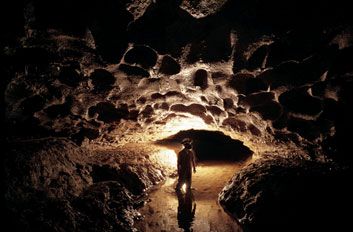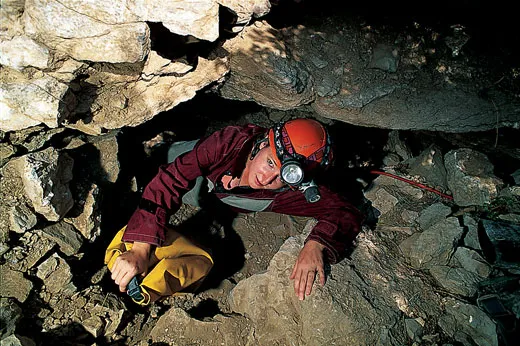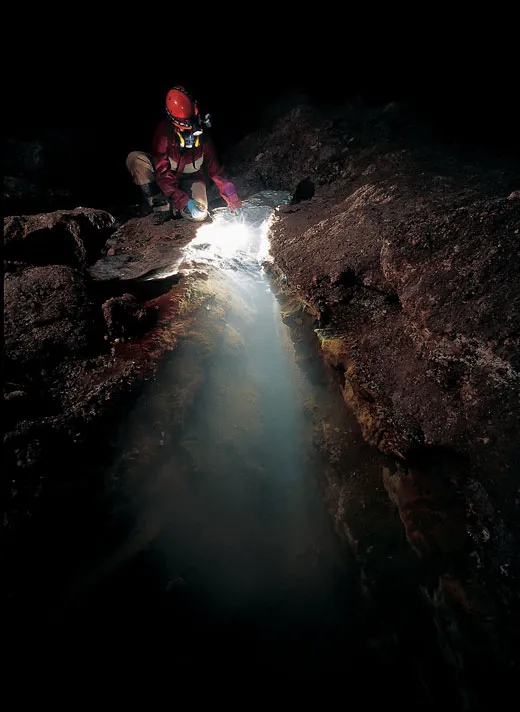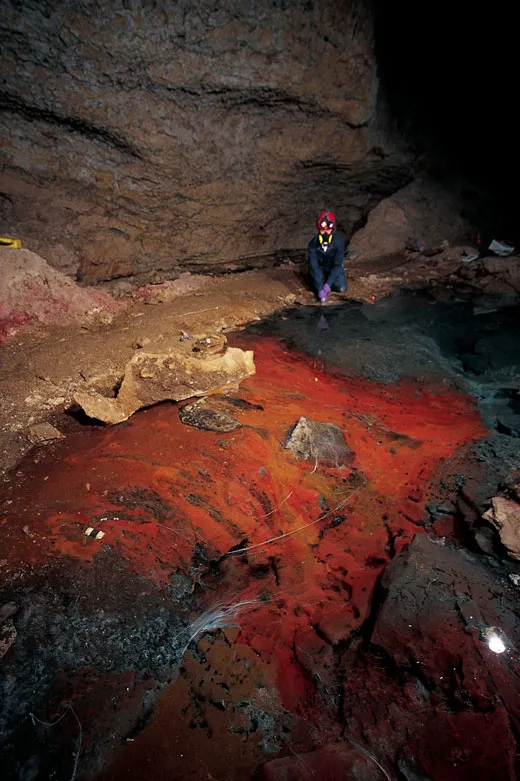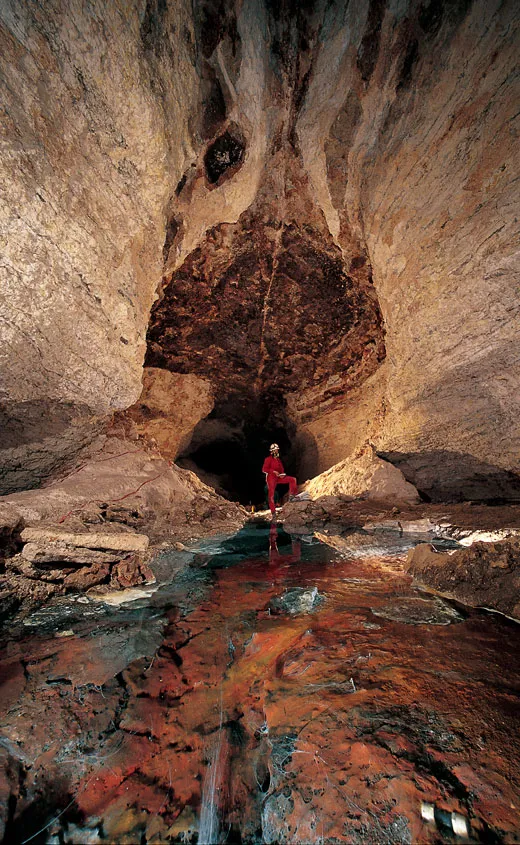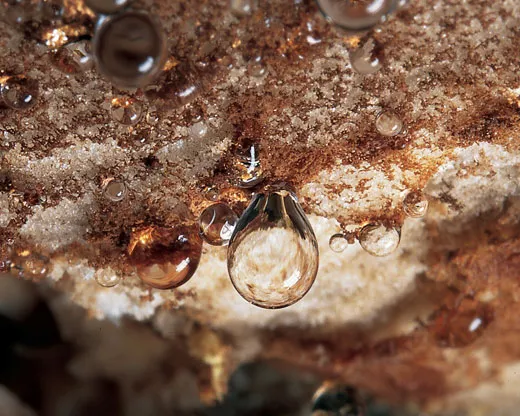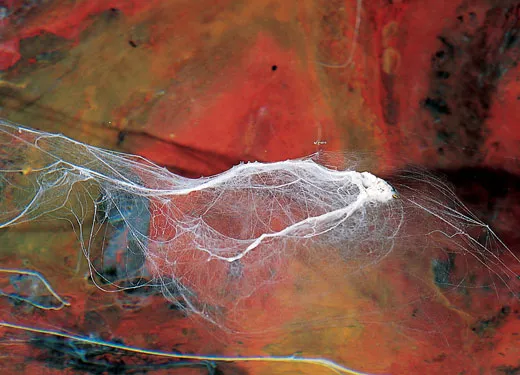Subterranean Surprises
Scientists are discovering that caves more complex than we ever imagined may yield vast riches about the origins of life
A few miles south of Lovell, Wyoming, near the Montana border, the Burlington Northern railroad begins a gradual climb out of pastures and cottonwood groves. The track rises into a honey-colored gorge cut through Madison limestone, a formation already ancient by the time dinosaurs roamed Wyoming’s seashores, then passes above an underground chamber, 30 feet below, known as Lower Kane Cave. The cave entrance is nearly invisible, a crack almost buried by the steeply piled rubble of the railway embankment.
Stumbling down this ankle-twisting slope behind a team of scientists, I squirmed feetfirst through the 30-inch crack. Bent double and fumbling my way forward in the gloom, I slipped into a fast-moving stream and floundered on all fours before finding enough room to stand upright on the mud bank. My eyes soon adjusted to the dim glow of my headlamp, but my skin remained sticky; unlike most caves at this latitude that stay pleasantly cool year-round, the temperature in Lower Kane hovers at an uncomfortably humid 75 degrees. An acrid, rotten smell stuck in my throat.
Lower Kane has none of the sparkling columns or limestone “draperies” of subterranean tourist spots such as New Mexico’s Carlsbad Caverns or Kentucky’s MammothCave. Scarcely larger than a typical New York City subway station, Lower Kane lacks even the humblest stalactite. Yet this unprepossessing cave is proving to be a scientific gold mine, drawing to its humid depths an energetic group of researchers, led by Annette Summers Engel of the University of Texas. Wearing safety masks to guard against toxic gases that bubble up from three spring-fed pools, the team is pursuing the latest chapter in a 30-year effort to understand the rare and exotic form of cave that Kane represents; only about a dozen of these so-called active sulfide caves have been found worldwide. When first proposed in the early 1970s, the theory of their origins was so controversial that the scientific community took nearly two decades to embrace it. Eventually, the unusual geochemistry of these caves overturned conventional thinking about how they were formed.
More significantly, the discovery of “dark life”—teeming colonies of microbes thriving in these acid-drenched, pitch-black netherworlds—has thrown out a long-held belief that caves are mostly barren and sterile places. Scientists are hunting in these once-hidden depths for microbes that may lead to new cancer treatments. And cave research is also affecting scientists’ thinking about the origins of life on earth and its possible existence on other worlds. “A cave is such a different environment, it’s almost like going to another planet,” says New Mexico Tech geomicrobiologist Penny Boston. “In a sense, it is another planet—the part of our own planet that we haven’t explored yet. Just as the deep oceans became accessible to science only in the past few decades, now we’re finding that kind of pioneering effort going on in caves.” (A television exploration of cave research, “Mysterious Life of Caves,” airs on PBS’s NOVA October 1.)
In the late ’60s, a StanfordUniversity graduate student searching for a challenging topic for his PhD thesis became the first scientist to squeeze through the crack in the Wyoming railway embankment. Stephen Egemeier’s curiosity was immediately aroused by Lower Kane’s unusually warm temperatures and unpleasant smells. Even stranger were the huge, muddy heaps of a crumbly white mineral rarely found in caves. This was gypsum, or calcium sulfate, the main ingredient in Sheetrock or drywall, the material familiar from house construction. When Egemeier discovered that Lower Kane’s springs were not only hot but were bubbling hydrogen sulfide gas (notorious for its rottenegg smell), he theorized that hydrogen sulfide was actively at work in carving out Lower Kane. Whatever underground source the potentially toxic gas ultimately came from—whether the volcanic reservoirs of Yellowstone to the west or the oil fields of the BighornBasin to the south—it was bubbling out of the springwater and into the cave. Naturally unstable, it was reacting with oxygen in the water to form sulfuric acid. The acid was eating away at the cave walls and producing gypsum as a by-product.
Egemeier’s pioneering research was never widely published and attracted little attention in the ’70s. But while it languished, another group of scientists was grappling with some equally puzzling cave riddles. This time, the scientific detective hunt unfolded far from Wyoming’s rugged canyons in the well-trampled depths of a major tourist destination, Carlsbad Caverns.
The early carlsbad story is essentially the story of a single individual, Jim White. As a teenager in the 1890s, White was wandering near his campsite in the GuadalupeMountains of southeastern New Mexico when he spotted a strange dark cloud swirling up from the desert floor. “I thought it was a volcano,” he said later, “but then I’d never seen a volcano.” Tracing the cloud to its origin at the mouth of a gigantic cavern, White stood transfixed by the spectacle of millions of bats pouring out on their nightly hunting exodus. So began his lifelong obsession with Carlsbad Caverns, which he generally explored alone, with only the feeble flicker of a kerosene lamp to guide him. White’s tales of a vast underground labyrinth made him something of a local laughingstock until he persuaded a photographer to accompany him into the cave in 1915. In the months that followed, White would lower visitors in an iron bucket on a wobbly winch into the darkness 170 feet below. Today, of course, his solitary obsession has become a national park drawing half a million visitors a year.
But perhaps the most surprising aspect of the Carlsbad story is that even as late as the 1970s, when daily summer visitors numbered in the thousands, the caverns’ mineralogy and its many puzzling features had hardly been studied. Speleology, or the study of caves, was barely a respectable science, and according to cave expert Carol Hill, mainstream geologists tended to dismiss as “grubby cavers” those who were attracted to the subject.
Then, one day in October 1971, Hill and three other young geology graduate students climbed a steep ladder into one of Carlsbad’s remote chambers. As they clambered about the Mystery Room, named for the strange noise made by wind there, they were baffled by patches of bluish clay at their feet and crumbly, cornflake-like crusts on the walls. Odder still were the massive blocks of a soft, white mineral elsewhere in the cave. Such blocks shouldn’t have been there at all.
For one thing, this mineral, gypsum, quickly dissolves in water. And the conventional explanation of how caves are formed involves the action of water—lots of it—percolating through limestone over millions of years. The chemistry is simple: as rain falls through the atmosphere and trickles into the soil, it picks up carbon dioxide and forms a weak acidic solution, carbonic acid. This mildly corrosive groundwater eats away the limestone and, over eons, etches out a cave.
According to this universally accepted theory, all limestone caves should consist of long, narrow corridors. Yet as anyone who has trekked through Carlsbad’s main attraction, the Big Room, knows, it is a gigantic, cathedral-like hall extending over the equivalent of six football fields. Had a major underground river carved out this immense cavern, it should have eroded or swept aside everything in its path, including gypsum. Yet giant white heaps of the stuff up to 15 feet thick lie on the floor of the Big Room, one of the largest cave spaces in the world.
Puzzled, Hill was forced to conclude that some drastically different method of cave formation must have been at work in the GuadalupeMountains. Soon she came up with a theory similar to Egemeier’s: that hydrogen sulfide given off by nearby oil and gas fields had risen up through the mountains and reacted with oxygen in groundwater to produce sulfuric acid, which had then eaten away the caves over millions of years.
Her hydrogen sulfide theory aroused intense skepticism among geologists, who sought proof, which Carlsbad, as a “dead” or no longer forming cavern, could not provide. To confirm Hill’s theory, scientists needed to investigate a site where sulfuric acid was still eating away at the cave—as it was at Lower Kane. But over the years the little cave under the railway track had been more or less forgotten.
In 1987, Hill’s meticulous study of the Guadalupes at last appeared, coinciding with the publication of Stephen Egemeier’s work after his death in 1985. These studies, along with new discoveries of a handful of other active sulfide caves around the world, proved beyond any doubt that caves in some regions were formed by sulfuric acid. But now a more tantalizing question arose: How could life thrive inside pitch-dark caverns full of toxic gas?
One of my spookiest moments visiting Lower Kane was when I aimed my flashlight beam at one of the cave’s three pools. Just below the water’s surface stretched a crazy pattern of stringy, filmy matting in startling shades of blue-black, vermilion and garish Day-Glo orange, as if some 1960s pop artist had tossed paint in every direction. In some places, the mottled, pitted orange patterns reminded me of NASA images of the barren surface of Mars. In others, it looked as if someone had dumped spaghetti sauce in the water. And floating in the water directly over each spring, spidery white filaments, like delicate cobwebs, performed a ghostly underwater dance in the currents bubbling up from below.
The psychedelic colors all belonged to bacterial mats, gelatinous films of carbon compounds generated by invisible microbes. These vivid by-products of bacterial activity can be seen clustering around hot springs in Yellowstone and elsewhere, though on the surface they can be overwhelmed by competition from algae and other organisms. But what were they doing here in Lower Kane, thriving so abundantly in a place with poisonous gases and no sunlight?
For most of the 20th century, scientists believed no bacteria could exist more than a few yards beneath topsoil or ocean mud; below that, scientists thought, life simply fizzled out. Then, in 1977, came the astonishing discovery of bizarre tube worms and other exotic animals, all huddled around submerged volcanoes so deep in the Pacific that sunlight does not reach them. This otherworldly ecosystem turned out to depend almost entirely on the activity of sulfur-loving bacteria, thriving on the scalding currents and gases released by undersea vents. Equally startling revelations about microbes in other unlikely places soon followed: bacteria were found in cores drilled more than a mile below Virginia, inside rocks from inhospitable Antarctica, and more than six miles deep in the Pacific at the bottom of the Marianas Trench. Some scientists now speculate that hidden subsurface bacteria may equal the mass of all living material above.
This “dark life,” isolated for billions of years, opens up tantalizing prospects for scientists. Microbiologists hope that underground bacteria can lead to new antibiotics or anticancer agents. NASA specialists are investigating them in hopes of identifying signatures that they might recognize in rock samples from Mars or in probes that may one day penetrate the frozen seas of Europa, one of Jupiter’s moons.
But the challenge for all these hunters of subterranean bugs is access, which is where Lower Kane comes in. “Caves offer a perfect walk-in window to the normally hidden world of microbial activity,” says Diana Northup, a cave investigator at the University of New Mexico. “Some researchers speculate that life evolved first underground and moved to the surface as conditions improved. If this is true, then studies of subsurface microbes may offer clues to the nature of some of earth’s earliest life-forms.”
Although LowerKaneCave had given me a soaking and a bruise or two, my discomforts were nothing compared with the miles of wriggling and squeezing required to penetrate many other sulfide caves. Its accessibility was one reason Lower Kane attracted Annette Summers Engel first in 1999 and every year since, allowing her and her team of geologists, geochemists and DNA experts to haul scientific equipment in and out with relative ease. Their initial tests quickly confirmed that Stephen Egemeier had been right: sulfuric acid, the result of hydrogen sulfide reacting with oxygen, was indeed still eating away the cave walls. The most intriguing question was whether Lower Kane’s bacterial mats were adding to the acid attack. Since some bacteria produce sulfuric acid as waste products, it certainly seemed possible. Summers Engel’s plan was to tackle the question from several different angles. A DNA test, for example, might identify particular microbes. Other tests might tell whether a microbe fed on, say, sulfur or iron, and whether it was stressed or flourishing.
Preliminary results bowled over the researchers. “When we first came to Lower Kane,” says Summers Engel, “we naturally assumed that each mat would mainly consist of sulfur-oxidizing microbes. That seemed like common sense. What we found, instead, was astonishing complexity.” Each mat, in fact, turned out to be as diverse as a Manhattan city block. There were plenty of sulfur-eating microbes, all feeding off the gases bubbling up in the springs. But there was a riotous mix of other bacteria too. For example, some, oblivious to sulfur, were feeding off the waste generated by their neighbors. Nor were the bugs all thrown together at random. Sulfur-eating bacteria, for instance, congregated at the top of the mat; as greedy consumers of oxygen, they needed the air at the spring’s surface to survive. Methane producers that need no oxygen were concentrated, predictably, at the mat’s bottom.
To find out how the mats as a whole were affecting the cave, the scientists devised a test of elegant simplicity, involving two plastic tubes, each containing identical limestone chips. The mouth of one was covered with a crude plastic mesh, allowing both microbes and water from the spring to swirl inside. The other was covered with a membrane that admitted water but kept out the microbes. After submerging both tubes in the spring for several months, the team studied the chips under a microscope. The chip exposed to both the acidic water and the microbes was more severely pitted and scarred than the one exposed to water alone. Here was the proof that acid-producing microbes were accelerating the creation of the cave. “There’s no question that microbes are adding to the acid chemistry that’s dissolving the limestone,” says University of Texas geochemist Libby Stern, “and that without the mats Lower Kane probably would be forming at a much slower pace.”
But another find was even more tantalizing: a totally new species of microbe, tentatively identified by BrighamYoungUniversity biologist Megan Porter. The new organism appears closely related to microbes found at undersea vents deep in the Pacific, a likely point of origin for the emergence of life. “This is an exciting discovery,” says Porter, “because it implies that the types of metabolisms found in LowerKaneCave are very ancient.” It also fits with growing evidence that life may have begun in the depths. In subsurface havens like caves, undersea vents and in the soil, primitive microbes would have been sheltered from the volcanic blasts, meteor bombardments and intense ultraviolet radiation that made the planet so inhospitable in its early years. In these ancient refuges, which humans have only just figured out how to penetrate, life evolved far from sunlight, often in extreme conditions of heat and acidity. Kane’s psychedelic mats remind us how extraordinarily diverse and hardy earth’s ancient pioneers must have been.
But the horizons of cave research stretch far beyond our own planet. Many astronomers and geologists speculate that Jupiter’s moon Europa and Mars each harbor water and subsurface conditions resembling our own. If microbes can survive in harsh conditions here, why not there as well? “Our work in caves has broadened the known limits of life on our own planet,” says Penny Boston. “But it’s also a great dress rehearsal for studying biological sites on other planets, and pushing our imaginations to connect earth’s ‘inner-terrestrials’ with those of outer space.”
